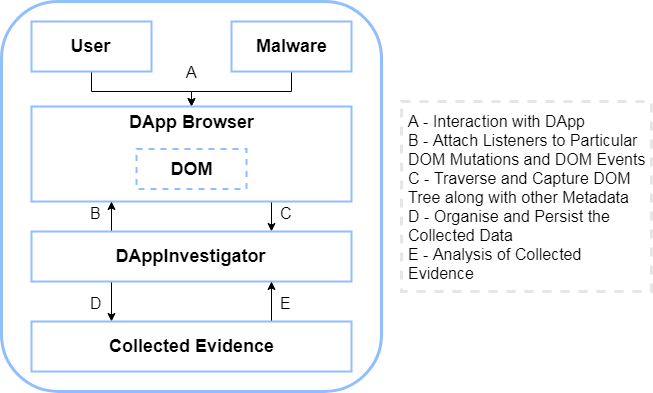DApps provide a solution where mistrusting entities are allowed to interact through a user-friendly environment, backed up by a security critical technology, more specifically the Ethereum blockchain [But14]. Given the setup, security guarantees that the blockchain offers are often misunderstood to cater for all possible threats. However, the added front-end interfacing components fall outside the scope of these guarantees and consequently increase the possible attack surface.
The first part of this work attempts to investigate how the added front-end components can be exploited to undermine the present architecture. Assuming that architectures such as crypto wallets cannot be compromised and private keys are not disclosed, we study the possibility of abusing DApp behaviour without the need to hijack security critical tokens. This led to the identification of a set of potential vulnerabilities, which can be studied within the optic of the following dimensions: 1) Exploitation of transactions through tampering and forgery; 2) Exploitation of the DApps functionality, either related to the nature of the application or cryptocurrency transfers; and 3) The implications that the DApp Browser in use has on the identified vulnerabilities. Based on this threat analysis, it was concluded that through DOM abuse, DApp functionality, and consequently transactions generated, can be compromised. However, the success of the exploit depends on the amount of visibility and control the DApp Browser provides during the transaction authorization process.
Considering that these types of attacks can go undetected for a number of days, traditional memory forensic techniques would be hindered in this scenario [Gar]. For this reason, DAppInvestigator was proposed, with the aim of providing an effective solution that targets these needs. Using the technique portrayed in Figure 1, we show that proactive system forensics revolving around dumping DOM-related information, driven by particular events emitted by the DApp Browser, can actually recreate the steps of eventual attacks and present them in a forensic timeline. The potential of this approach was demonstrated using two implementations that require a different level of TCB. In using a TCB that consists of the entire web browser stack and a second version which only relies on DevTools Protocol server code of the browser, we manage to set a solid basis for response.

References
[But14] Vitalik Buterin. Ethereum white paper: A next generation smart contract & decentralized application platform. Report, Ethereum. org, 2014. [Gar] Gabriela Limon Garcia. Forensic physical memory analysis: an overview of tools and techniques
Student: Franklyn Josef Sciberras
Supervisor: Dr Mark Joseph Vella
Course: B.Sc. (Hons.) Computing Science
